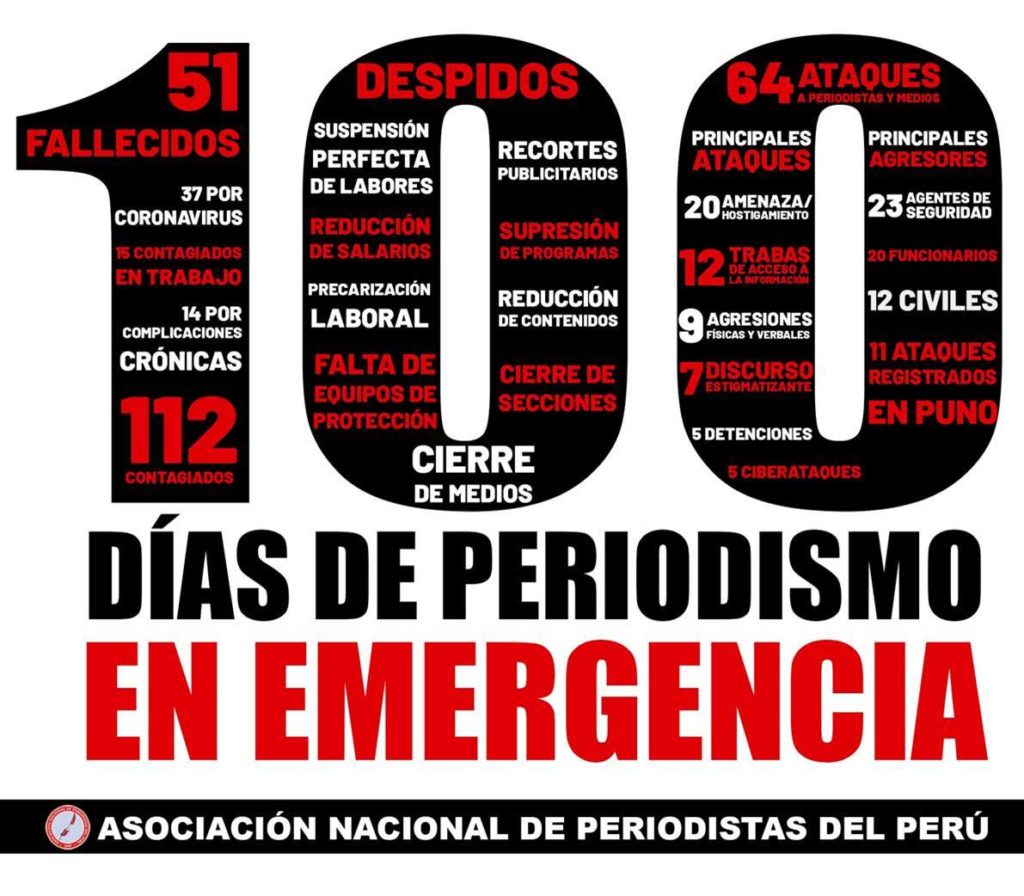During the hundred days of national emergency in Peru, 51 journalists have died. Of this total, 37 lost their lives as a result of the coronavirus (15 infected in journalistic activity), while 14 died from complications of other diseases, due to lack of care due to the collapse of the health system. Likewise, the death of 4 other media workers has also been reported.
This information has been registered by the National Association of Journalists of Peru (Asociación Nacional de Periodistas del Perú – ANP), which, since the beginning of the national emergency (March 16), has maintained a permanent action to monitor the situation of journalists throughout the country.
Likewise, to date there are at least 112 cases of contagion in the sector, whose focus has migrated through the regions of Loreto, Ucayali, Tumbes and Ancash. Similarly, in Puerto Maldonado, out of 18 journalists who took the rapid test, 16 gave a positive result.
Labor pandemic
Local and regional media received the first impact of the confinement. The newspapers abandoned paper printing – in the absence of sales and advertising – and migrated to their digital versions to continue their informative mission, but with no chance of economic survival. The minimum or no advertising revenues caused the cut in radio and television programming and the reduction of pages in the regional editions of the national media.
Journalists from the regions, as independent workers, have suffered the greatest impact of the health, economic and social crisis, to the point of putting their survival and that of their families at risk by having no income from their work and not having been benefited – 80% – by none of the measures given by the government.
The large media conglomerates – in spite of having accessed programs such as Reactiva Peru (cheap credits aimed at maintaining employment) or other assistance mechanisms – such as the subsidy to companies that covered 35% of the salary of workers earning up to 1,500 soles – applied, in some cases, the perfect suspension of work (ATV case, in the south of the country).
Among the most serious forms of labor affectation that the ANP has registered are the dismissal of correspondents in the provinces (first victims); as well as the dismissal of more than 50 workers in the newspaper La República and what happened in the El Comercio Group, which after applying a series of salary reduction measures camouflaged the dismissal of more than a hundred workers. Prior to this, the closure of two media outlets of the group, Publimetro and the newspaper El Bocón, was announced.
Added to this is the situation of the workers of Corporación Universal (Diario Exitosa and Exitosa TV), whose labor abuse has been registered since before the pandemic began. The change of social reasons of the media companies, the bankruptcy, among others, are recurring figures in this group to evade the payment of social benefits.
Emergency exacerbates attacks on journalists and media
Another worrying figure is the 64 attacks on journalists and the media that the ANP’s Office of Human Rights of Journalists (Oficina de los Derechos Humanos del Periodista – OFIP) has registered during the national emergency, with Puno being the region with the most registered cases (11).
Among the most common attacks, threat/harassment stands out, with 20 cases; followed by obstacles to access to information (12) and physical and verbal attacks (9). They are followed by stigmatizing discourse (7), arrest (5) and cyber-attack (5). Likewise, there has been judicial intimidations (2) and workplace harassment (4).
Likewise, the most frequent offenders are the security agents (police, military, municipal police force, security guard), who have led to 23 attacks on journalists, followed by officials (20) and civilians (12). Unidentified elements (5) and employers (4) follow.
Trade union actions
During this period, the National Association of Journalists of Peru has maintained a constant action to make the situation of the journalistic sector in the country visible. This has been achieved thanks to the meticulous registry of infected and dead journalists at the national level, based on the information provided by the more than one hundred ANP branches nationwide.
The ANP has granted more than 32 of its affiliates affected by COVID-19, humanitarian assistance, through an economic subsidy to attend to medicines. It has been repeatedly demanded by the Ministry of Health and Presidency of the Council of Ministers, to provide Personal Protective Equipment (EPPs) to journalists from regions – generally, without distinction of their affiliation – to cover the pandemic on the front line. There is an initial commitment by Presidency of the Council of Ministers to meet this requirement, considering the high degree of risk exposure that those who continue to carry out information coverage on the street have.
At the same time, legal advice is being provided to dismissed journalists, who have demanded it, and an emotional contingency program is being carried out to confront the pandemic.
Lima, 23 June 2020
National Executive Committee





